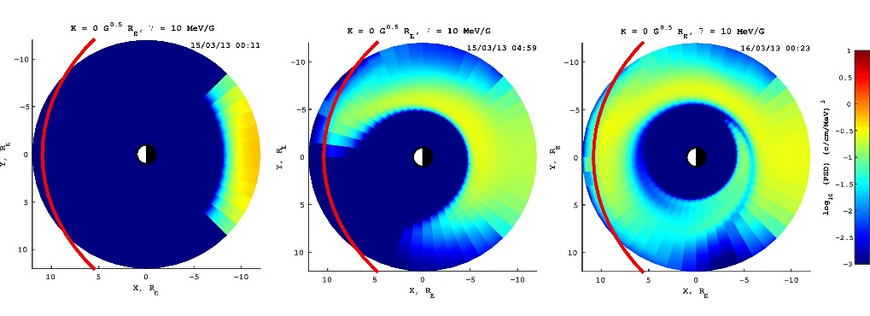Ring Current Modelling

The ring current is an electric current encircling the Earth at the distances between ~3 and ~5 Earth’s radii from the center of the Earth in the equatorial plane. The ring current moves clockwise when viewed from the Earth’s north pole and is carried by drifting in opposite directions electrons and ions of ~1 – 200keV energies. The ring current particles originate from the Earth’s plasma sheet, where they move earthward under the action of the dawn-to-dusk electric field and magnetic field of our planet. During geomagnetic storms, the ring current intensifies and decreases the Earth’s magnetic field leading to the so-called Dst effect at the main phase of the storm. At the recovery phase of the storm, the ring current decays due to scattering of the charged particles by field changes, plasma waves (e.g. electromagnetic ion-cyclotron waves), or charge exchange with neutral atoms. The ring current is a crucial component in our understanding of the magnetosphere dynamics and geomagnetic storms, and it can also affect human infrastructures such as high-latitude power grids or currently operating communication or navigation satellites.
We use the four-dimensional Versatile Electron Radiation Belt (VERB-4D) code to model the dynamics of the ring current. The code solves the three-dimensional diffusion equation describing particle loss and acceleration due to wave-particle interactions and two-dimensional convection equation allowing for modeling particle drift in external electric and magnetic fields. The VERB-4D code has been originally developed for ring current and radiation belt electrons, tested and validated [Aseev et al., 2016], and successfully applied to modeling of 17 March 2013 storm [Shprits et al., 2015].
In this project, we apply the code for the ring current ion species, which is possible since the ion dynamics is governed by the same equations as the electron dynamics. We test and validate the code by running it for particular storms and long-term periods and comparing the results with satellite observations. We study the sensitivity of the code to prescribed empirical models of electric and magnetic fields and different parameters such as diffusion coefficients or charge exchange loss rates. We model the evolution of the ring current during onset, main and recovery phases of the storm. Finally, we investigate the possibility to model the ring current self-consistently by coupling the code with codes modeling electric and magnetic fields. As a final product, we will make a predicting system that will be publicly available on the Internet.
References:
Aseev, N. A., Y. Y. Shprits, A. Y. Drozdov, and A. C. Kellerman (2016), Numerical Applications of the Advective-Diffusive Codes for the Inner Magnetosphere, Space Weather, 14, doi:10.1002/2016SW001484.
Shprits, Y. Y., A. C. Kellerman, A. Y. Drozdov, H. E. Spence, G. D. Reeves, and D. N. Baker (2015), Combined convective and diffusive simulations: VERB-4D comparison with 17 March 2013 Van Allen Probes observations, Geophys. Res.Lett., 42, doi:10.1002/2015GL065230.


